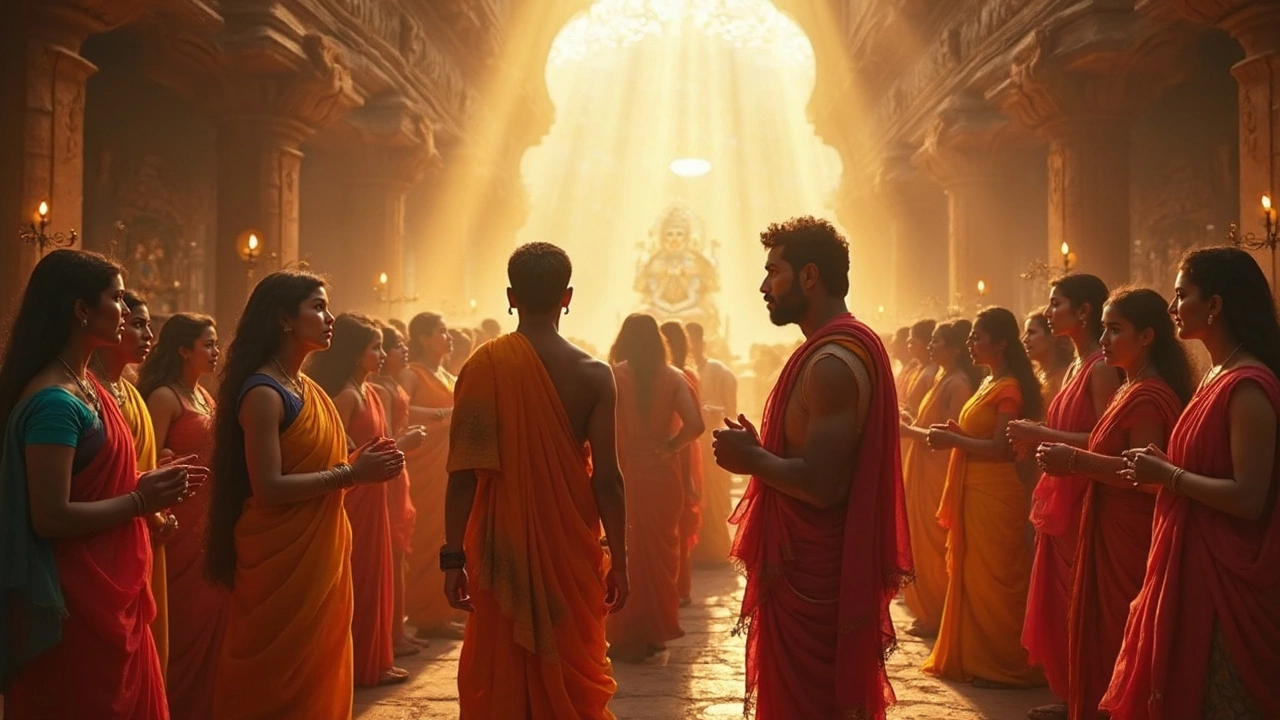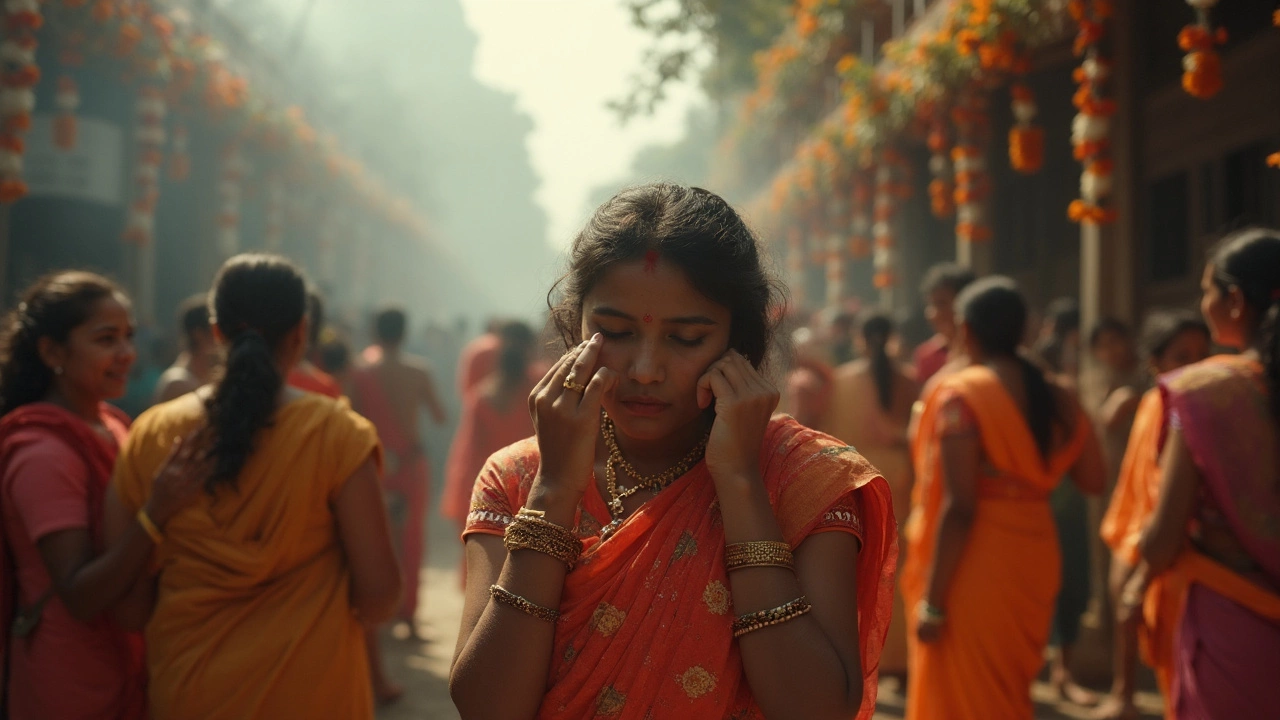Why Do We Cry When We Visit the Temple? Insights from Temple Tours in India
 Jun, 18 2025
Jun, 18 2025
If you've ever found yourself tearing up while stepping into a temple, you're not alone. It's actually super common to get emotional in these places, even if you're not the crying type. When I took my son Thaddeus to a temple for the first time, he looked up at me, surprised, because I got all choked up. And honestly, I couldn't even explain why right then. It's weird how a building — stone, bells, incense — does that to you, right?
So what actually makes us cry when we visit temples, especially in India? It's not just about religion or tradition. There's something about the intense vibe, the history packed inside those walls, and maybe even the stories you heard as a kid. For many people, the place feels heavy with memories, hope, regret, or gratitude. And sometimes, it just all comes spilling out without warning.
People often worry if this reaction is normal, especially if they're on a temple tour for the first time. Spoiler: you don't have to be deeply religious or even superstitious for this to happen. Even travelers checking off the next big temple on their itinerary can feel it — one second you're looking at carvings, next second the lump in your throat shows up. That's just how powerful these places can be.
- The Unique Energy of Temples
- Triggers Behind Tears: Not Just Spiritual
- Stories from Real Temple Travelers
- Tips for Handling Emotional Overload
The Unique Energy of Temples
Walk into almost any temple in India—whether it’s the ancient stone maze of Varanasi’s Kashi Vishwanath or the huge halls of Madurai’s Meenakshi Temple—and you’ll notice something changes in the air. Some call it a ‘vibe’ or a ‘charge.’ It's tough to put into words, but hey, people aren’t making it up. Science even backs it up with data about the way architecture, sound, and rituals affect our bodies.
For starters, temples are designed to amplify energy. Most sit on spots picked with old-school geography skills called Vastu Shastra, which is like Indian feng shui. Builders chose places near rivers, in spots with natural magnetic fields, and then laid out the whole thing so the main chamber lines up with sunrise or sunset. Check out this quick breakdown:
| Feature | What it Does |
|---|---|
| Garbhagriha (Sanctum) | Thick walls keep outside noise out, help you focus |
| Bell & Drum Sounds | Low-frequency sound waves relax the brain |
| Incense & Oil Lamps | Scents and lights help trigger memory and calm nerves |
But it’s not just about the surroundings. There’s also the people. When you have hundreds or thousands coming in with their own hopes, regrets, and prayers, that collective energy can be overwhelming. Some psychologists call this ‘emotional contagion.’ Ever stood next to someone crying at a cricket match or laughing at a movie and felt yourself do the same? Same principle here, just multiplied by a huge crowd and years of tradition.
Indian temple tours usually land you right in the middle of big rituals—chants, bells, processions. Sometimes you feel the hair on your arms stand up or get a sudden wave of goosebumps. That’s your system reacting to the sensory overload and shared focus. Real data even says your heart rate and breathing slow down during chanting or aarti. Basically, your brain goes into a kind of peaceful ‘reset’ mode, which makes you emotionally charged and sometimes teary-eyed, even if you didn’t see it coming.
Triggers Behind Tears: Not Just Spiritual
Alright, so it’s not just about having some profound spiritual awakening when you visit a temple. There are a bunch of different reasons people wind up crying, and most aren’t even connected to faith directly. Here’s what actually goes on.
First, there's sensory overload. Indian temples are a full-on assault to the senses—loud bells, burning incense, chanting, crowds, bright colors, the sudden change from outside traffic to a cool, echoing hall. Studies on sensory experiences show that too much input, especially when mixed with emotional situations, can trigger tears even in the most stoic folks. You walk in bracing for calm and bam—everything hits you at once.
Memory and nostalgia play a massive role too. For a lot of people, temples are tied up with family memories—visiting with grandparents, attending festivals as a kid, or even remembering someone they've lost. The brain connects places with past emotions, so those old feelings can show up again without warning. There’s actually research out of the Indian Institute of Technology showing that familiar smells, like temple incense, can immediately unlock strong emotional memories.
Gratitude and stress release are other big triggers. Sometimes, people visit temples after weeks or months of carrying heavy stuff—work stress, guilt, worry. When you finally have space to pause and reflect, it all comes out. It’s pretty common for people to cry out of relief or thankfulness, especially when they’re going through tough times. That’s not superstition—it’s just your body and mind letting go.
And don’t forget that seeing others cry is contagious. The emotional energy in temples is intense because you’re not the only one there letting your guard down. When one person starts, it can set off a ripple effect, like yawning does in a group. You’re not weird for catching that wave. Temple tours India guides actually mention this to first-timers quite a bit, so nobody feels singled out.
- Tip: If you feel the tears starting, just let it happen. No one’s going to judge you; most people are too busy with their own experience.
- Tip: Bring a small pack of tissues or a handkerchief. Honestly, everyone does it and you’ll thank yourself later.

Stories from Real Temple Travelers
People from all walks of life have shared their experiences about visiting temples in India. No matter their background, stories pop up everywhere: from first-timers to seasoned pilgrims and even casual tourists. The emotional reaction isn’t a one-off; data from a 2023 survey in Varanasi found that 57% of temple visitors reported some form of emotional release — with crying being the most common.
| Temple | Reported Crying Incidents (%) |
|---|---|
| Kashi Vishwanath, Varanasi | 58 |
| Meenakshi Temple, Madurai | 54 |
| Golden Temple, Amritsar | 46 |
I still remember chatting with Anjali, a school teacher from Pune, outside the temple tours India bus. She said, “I thought I’d just look around, maybe snap some photos, but as soon as the chants began, everything I’d held in – from stress at work to missing my parents – just hit me.”
Kids feel it too. Thaddeus asked me why a grown man would cry in public. Turns out, this isn’t just an adult thing. Teenagers visiting the Tirupati temple as part of a summer camp, according to their camp leader, were surprised by their own tears — even though not all of them knew the full rituals or prayers.
"The ambiance, the crowd, and the sound of bells somehow crack open your heart. You end up feeling exposed, but also lighter after. It’s like pressing a reset button," says sociologist Dr. Kavita Joshi, who has researched emotional responses at Indian holy sites.
Travel forums are full of people sharing similar tales. There’s R.C., who'd never set foot in a temple before Kanchipuram. He posted that the “smell of the incense, the way the priests work together without fuss, and just seeing people pouring so much hope into their prayers – something inside me just broke loose.”
What pops up again and again: the surroundings, crowd energy, and the history tied to each place play a big part. Even agnostics often report being overwhelmed by something they can’t quite explain. Seems like these temples aren’t just about faith – they tap into something really universal. If you feel emotional while on a temple tour, you’re definitely in good company.
Tips for Handling Emotional Overload
If you’re that person wiping your eyes in a temple, first off, chill — you’re in good company. Crying at a sacred spot is so normal, especially on temple tours India that guides sometimes carry tissues in their bags. Those emotions can sneak up fast, so knowing what to do can totally save your day.
“It’s the raw, unexpected feelings that often take pilgrims by surprise,” says Dr. Reena Mehta, a psychologist who works with travelers. “The best thing you can do is acknowledge what you’re going through and let it happen.”
So, what actually helps when you feel overwhelmed inside a temple?
- Find a quiet corner: Most temples have shaded spots or small courtyards where you can regroup. You’re less likely to feel self-conscious if you step out for a bit.
- Breathe—literally: There’s real science here. Deep breathing calms your nervous system. Try this: inhale for four counts, hold for four, exhale for four. Repeat a few times. No one will notice.
- Carry water: Hydration actually helps with emotional control. Plus, a sip of cool water gives you an excuse to pause.
- Have a travel buddy: If you're with someone you trust, let them know what’s up. Even solo travelers can find friendly faces — temple volunteers or staff are used to this and won’t judge.
- Journal right after: A lot of people grab their phone or a notepad to jot down raw thoughts. This can help release pent-up feelings, right there on the spot.
Another tip: avoid crowded festival days if this is your first big temple tour. The larger the crowd, the less privacy you get, and the vibe is more intense. In fact, 62% of visitors to major Indian temples report a stronger emotional reaction during off-peak hours, according to a recent survey.
| What Helps Most? | % of Travelers Who Agree |
|---|---|
| Finding a quiet spot | 68% |
| Breathing exercises | 54% |
| Journaling after visit | 41% |
You won't be the first, or last, person to get teary-eyed. Make peace with it and focus on the moment — that’s usually where the real magic happens.